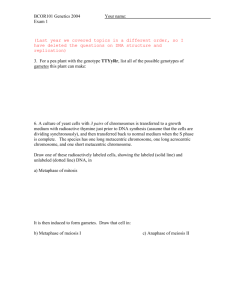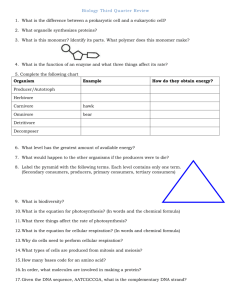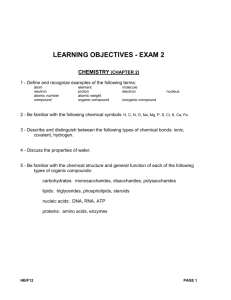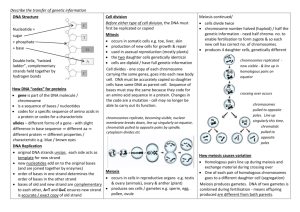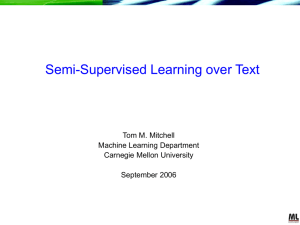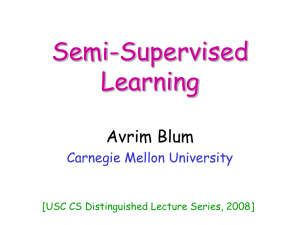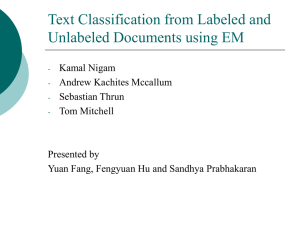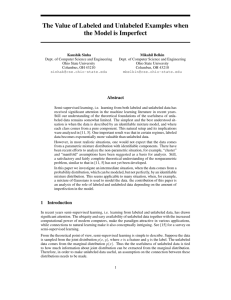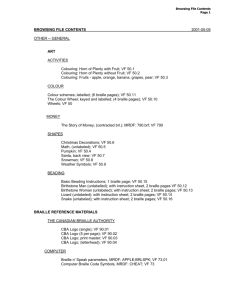Sample Exam 1 answer key
advertisement
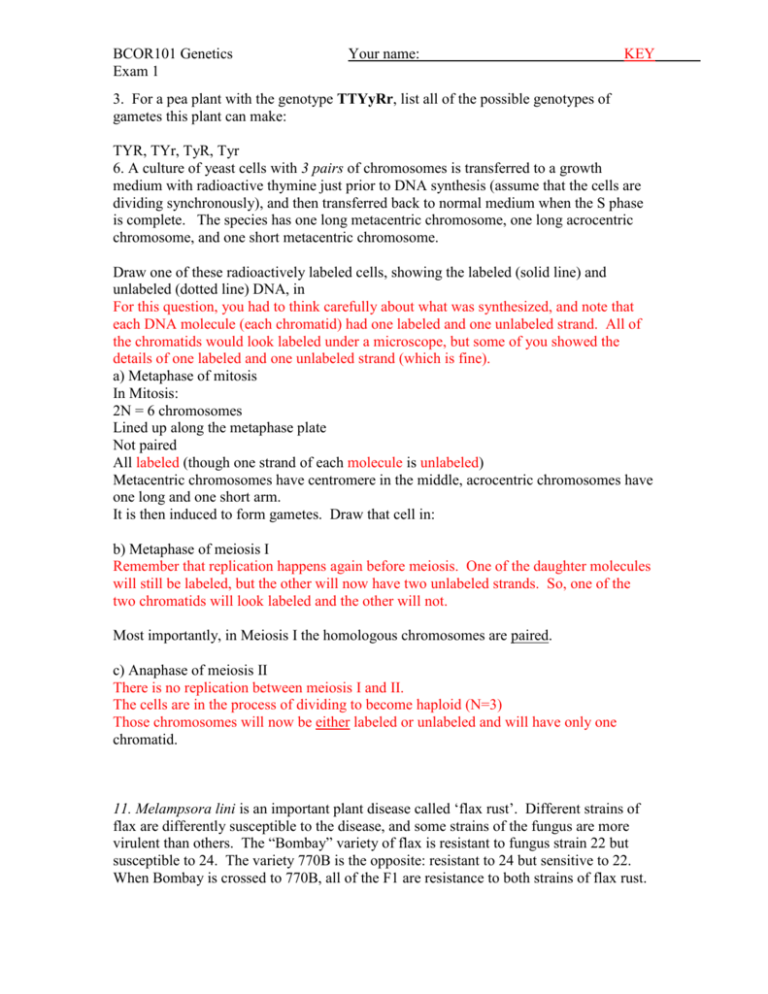
BCOR101 Genetics Exam 1 Your name: KEY 3. For a pea plant with the genotype TTYyRr, list all of the possible genotypes of gametes this plant can make: TYR, TYr, TyR, Tyr 6. A culture of yeast cells with 3 pairs of chromosomes is transferred to a growth medium with radioactive thymine just prior to DNA synthesis (assume that the cells are dividing synchronously), and then transferred back to normal medium when the S phase is complete. The species has one long metacentric chromosome, one long acrocentric chromosome, and one short metacentric chromosome. Draw one of these radioactively labeled cells, showing the labeled (solid line) and unlabeled (dotted line) DNA, in For this question, you had to think carefully about what was synthesized, and note that each DNA molecule (each chromatid) had one labeled and one unlabeled strand. All of the chromatids would look labeled under a microscope, but some of you showed the details of one labeled and one unlabeled strand (which is fine). a) Metaphase of mitosis In Mitosis: 2N = 6 chromosomes Lined up along the metaphase plate Not paired All labeled (though one strand of each molecule is unlabeled) Metacentric chromosomes have centromere in the middle, acrocentric chromosomes have one long and one short arm. It is then induced to form gametes. Draw that cell in: b) Metaphase of meiosis I Remember that replication happens again before meiosis. One of the daughter molecules will still be labeled, but the other will now have two unlabeled strands. So, one of the two chromatids will look labeled and the other will not. Most importantly, in Meiosis I the homologous chromosomes are paired. c) Anaphase of meiosis II There is no replication between meiosis I and II. The cells are in the process of dividing to become haploid (N=3) Those chromosomes will now be either labeled or unlabeled and will have only one chromatid. 11. Melampsora lini is an important plant disease called ‘flax rust’. Different strains of flax are differently susceptible to the disease, and some strains of the fungus are more virulent than others. The “Bombay” variety of flax is resistant to fungus strain 22 but susceptible to 24. The variety 770B is the opposite: resistant to 24 but sensitive to 22. When Bombay is crossed to 770B, all of the F1 are resistance to both strains of flax rust. BCOR101 Genetics Exam 1 Your name: KEY Those F1 are self-fertilized and you get the following data: Resistant to strain 22, sensitive to strain 24 Resistant to 24, sensitive to 22 Sensitive to both 22 and 24 Resistant to both 22 and 24 41 plants 35 plants 9 plants 110 plants Explain the likely inheritance pattern of resistance to flax rust. These F2 progeny are a pretty good fit to a 9:3:3:1 ratio, showing the independent assortment of two different genes. In both cases sensitivity is recessive. 12. In the fruit fly Drosophila melanogaster, ebony body (eb) is a recessive mutation. A true breeding line with ebony body was crossed to the wild type line and the offspring mated among themselves to produce an F2 generation. What proportion of the flies in the F2 had normal body color? 3 / 4 of the F2 will have normal color If all of the normal F2 flies are allowed to mate among themselves, what proportion of their offspring will have ebony bodies? 1/9.To answer this, you first have to realize that normal flies will have two different genotypes: EE and Ee. One third of them will be EE and two thirds will be Ee. Then you construct a branch diagram and multiply the probabilities. The only way to observe ebony bodies in the progeny of normal parents is for both parents to be heterozygotes. Dad will be Ee with probability 2/3, Mom will be Ee with probability 2/3. From that mating, ¼ of the offspring will be homozygous recessive (ee). So, 2/3 x 2/3 x 1/4 = 1/9 13. Huntington’s disease is a rare dominant trait that causes neurodegeneration later in life. It is rare enough that a randomly chosen person almost certainly does not have the disease. A man in his thirties, who already has three children, discovers that his mother has Huntington’s disease a) What is the probability that he will develop the disease? 1/2 Because the disease is very rare, Mom is almost certainly a heterozygote. In that case, he will have a 1/2 chance of getting the dominant gene for Huntington’s disease from her. b) What is the probability that his first child will develop the disease? IF he has the disease, then the child has a ½ probability of inheriting that allele. You also have to multiply it times the probability that he has the allele (from part A). So, 1/2 * 1/2 = 1/4 BCOR101 Genetics Exam 1 Your name: KEY c) What is the probability that at least one of his three children will develop the disease? This one is somewhat tricky. You probably know that you need to sum the probabilities of each of the children getting the disease, because it is a question of the general form child 1 or child 2 or child 3. However, the precise answer is not a simple sum: If he has the disease, then each child has a 1/2 probability of getting it or not: Child 1 Child 2 Child 3 prob =1/2*1/2*1/2 Y Y Y 1/8 Y Y N 1/8 Y N Y 1/8 Y N N 1/8 N Y Y 1/8 N Y N 1/8 N N Y 1/8 N N N 1/8 To get the probability that at least one of the children has it, sum the first 7 rows, which is 7/8. Now multiply it by the probability that he has the disease in the first place: ½ * 7/8 = 7/16 whew! Your book discusses several topics that we did not cover in detail during lecture. Choose TWO of the following questions from the book: These questions are from last year’s book, but I will probably ask questions about things we didn’t cover in lecture. 14. What it the difference between A, B, and Z DNA? A: dehydrated form of B; more bases per spiral; probably not found in cells B: the normal DNA of Watson and Crick and most common form in cells Z: opposite spiral, zig-zag structure. Rare. 15. In E. coli, how does DNA replication get started? (is there a particular signal or location? What are the initial steps?) see fig. 3-5Initiator proteins bind to the specific sequence, oriC. The DNA wraps around those proteins which allows helicase to bind and start unwinding the strands. 16. If a man with type A blood marries a woman with type B blood, what blood types could their children have? If more than one, which is/are most likely? Parents could be AA or Ao and BB or Bo Thus all four types of progeny are possible, A, B, AB or O AB is most likely BCOR101 Genetics Exam 1 Your name: KEY 17. Some microorganisms (and the mitochondrion of at least one plant) replicate their DNA by rolling circle replication. How does that differ from “standard” the mode of replication we discussed in class? See fig 3-12 A nick is made in one strand and the leading strand is copied continuously around and around the circle. The lagging strand is the same as always.

